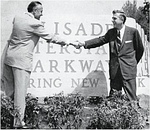Palisades Parkway Seventieth Anniversary
70 years ago in 1946 the final design for a new, 42- mile interstate parkway from the George Washington Bridge to Bear Mountain was completed. The conception of a scenic drive along the Palisades was initially proposed in 1909 but did not gain traction until 1935 when John D. Rockefeller, Jr. donated the needed land in New Jersey to make a continuous highway possible. The parkway took 12 years and $47,000,000 to complete and was originally anticipated to handle 22% of all the traffic bound for the George Washington Bridge. Traveling mostly unnoticed, over 60,000 cars now pass through our town daily using the parkway.
Unimaginable today, the parkway design drew a line directly through our town; however, with public enthusiasm for New Deal projects and the Robert Moses urban planning machine in high gear, the plan moved forward. Opposition by conservationists was immediate and initial plans to widen the existing Route 9W were rejected in favor of building the new parkway.
Keeping in mind that only a few years earlier, opposition groups were unable to prevent tens of thousands of people from being displaced when in the name of progress, Moses’ scalpel carved a mile long section out of Bronx neighborhoods for the creation of the Cross Bronx Expressway, so any urban planning opposition fight in that day was surely an uphill battle. Although parkway construction demolished several historical houses in its path, including two here in our own town, remarkably, only two pieces of land, both in New Jersey, were acquired through condemnation. The conservationists did prevail on a few fronts by getting the commission to create the 165-acre Greenbrook sanctuary in Tenafly, New Jersey to offset some of the land that was to be clear cut.
With ample land and federal money, no aspect of the highway design was compromised. Described in the commission’s completion story, the parkway “embodied the most advanced design of modern, limited access highways.” Like many public projects in its time, it was surrounded by pomp from the start. Even a one mile demonstration drive was opened to the public in 1948 to show off its intended grandeur. Separated opposing lanes, natural stone overpasses, offset roadway elevations to eliminate headlight glare and minimum sight distances of 1000 feet are all advertised as features in a 1958 driving brochure. The enthusiastic brochure continues its jubilant promotion by proclaiming “Nature has set a magnificent stage along the top of the Palisades in New Jersey and the Hudson Highlands through which engineers threaded the parkway. It is embroidered with a beauty that is peculiar to each passing season.”
Today the Palisades Parkway stands much unchanged from the day it opened in 1958. In 1992 it was designated a Scenic Byway and then as a National Landmark in 1998 by the National Park Service. As someone who uses the parkway frequently, I always look forward to making that first right turn off of the bridge knowing that I am soon leaving the chaos and traffic of the city behind me.



